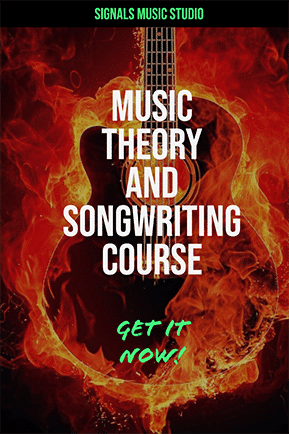Every now and then you’ll come across a chord progression that is so well constructed you’d sell a body part just to have written it yourself.
Fortunately, you don’t have to cut off body parts to write good progressions.
One thing I like to do is take those perfect progressions, analyze them, and figure out what makes them tick, how they affect your mood, and how they relate to theory you already know. In this breakdown, I’ll walk you through what I consider to be a perfect chord progression: Bruno Mars’ “When I Was Your Man.”
If you enjoy this blog post, or are struggling to understand some of the theory concepts, do check out The Chord Progression Codex. It’s a complete guide to understanding modern chord theory from the ground up.
The Verse: Tonal Ambiguity
The verse uses primarily chords from the key of C major, which are as follows:
However, the verse progression does not begin on a C major chord, and instead starts on the vi triad, Am. The actual tonic chord, C, only shows up for brief moments. When it does, it provides a quick bit of relief, and then slips away again to leave us hanging. The overall effect is one of tonal ambiguity – this progression could be considered the key of C major or the key of Am, depending on which chord your ear is hearing as “home base.”
That C chord, the one our ear naturally wants to hear as home, always seems just a bit out of reach. We never stay there long enough to feel secure, which gives the verse that morose, somber attitude.
It’s worth noting, also, that G/B chord at the end is played with an added high C note as well, making it more of a Gadd11/B to be more specific.
The Dark Turn
After the verse progression happens twice, we stay on Am for an extra measure to really darken things up. Am is vi chord, the home to our relative minor, and staying here long enough will firmly convince our ear that it’s our home chord. Then comes the darkest chord in the song: Em, the diatonic iii chord. To me, this puts black clouds over the horizon, especially when arriving here from the dimly-lit Am chord.
But then it gets quite interesting. From Em, we jump to B♭ major – a tritone away. That’s incredibly disruptive, but I love the effect. It’s a very quick inspirational moment where you feel a little hope and optimism.
We can see that B♭ is the ♭VII chord, which isn’t in key but is a borrowed chord that is frequently seen hanging out in major-key compositions anyways. After that, we see the beginnings of a cadential 64, as C/G moves to G. This strongly implies an upcoming tonic chord, C, but again this song keeps it just at arms reach as the upcoming chorus doesn’t even feature a C chord till it’s third measure.
The Chorus: Brilliant Simplicity
The centerpiece of this song is the 16-measure chorus in C major. It starts with something incredibly simple – a IV-V-I progression. F major, G major, C major. This is nursery rhyme stuff, your first day of music theory. The progression occurs twice, conditioning us to expect it a third time.
Instead though, we’re twisted away into Am, the vi chord minor.
This deceptive cadence, where the V resolves to the vi, hits like a punch to the gut. It’s doubly deceptive because we’ve been fooled into thinking the pattern would continue. This is the first taste of heartache in an otherwise light, lovey-dovey chorus.
The Major II
What follows that darkness is a big splash of brightness – D major, which is totally out of the key of C major. Where does this D major come from?
I personally like to think of this major II chord as being borrowed from C Lydian. C Lydian contains D as its II chord, and its presence always provides an inspirational bit of brightness. You could also think of D as a secondary dominant (V/V), but it doesn’t function that way here. D is “supposed to” move to G, but as we’ll see in this case, it moves straight to F (our diatonic IV chord).
Right after that ephemeral brightness, a new chord arrives with some emotional turmoil: Fm, and its appearance rings a heartbreaking tone. Again, it’s an out-of-key chord (nondiatonic), and again we can think of it as a borrowed chord. In this case, it’s helpful to think of Fm as being borrowed from our parralel minor key of C minor. Songs in the key of C will often feature notes and chords from Cm.
Then finally, things resolve back to C, the tonic. That change from iv – I is commonly referred to as a minor plagal cadence, and it’s a frequent trope in love songs and ballads.
The Bridge and Outro
The bridge starts on the IV chord rather than the tonic, which is common for bridges. It sets up a long journey back to the tonal center, and features a lament bass: that’s a bass voice that descends from our root note (C) down to the fifth (G). This occurs through a popular progression of inverted chords shown below.
Next is that II chord again, D major. But quickly it changes to Dm7, a diatonic variation of the ii chord. This is another cool example of how major and minor chords might show up side-by-side. We saw it earlier as IV became iv, and now II is becoming ii. Then finally, we’re given another strong “attempted cadential 64” to lead us into a final chorus
Why It Works
This song succeeds with just Bruno and a piano – no bass, no drums, no guitar. It’s pretty hard to write a hit song with that instrumentation. What supports it so well is this perfect chord progression, combined with Bruno’s amazing voice and flawless song structure.
The progression has all the cliches I love, but none are overdone. It uses:
- Deceptive cadence (V-vi instead of V-I)
- Borrowed chords (major II, minor iv, ♭VII)
- Tonal ambiguity between major and relative minor
- Chromatic voice leading
- Strategic use of tension and release
The Takeaway
Hopefully this analysis shows why we learn music theory – to better understand the music we enjoy and to write music that affects people emotionally. The progression works because it takes simple, familiar elements and combines them in sophisticated ways that create a specific emotional journey.
The key lesson is how tonal ambiguity can enhance a song’s emotional impact. By concealing the tonic and making it compete with the relative minor, you create that in-between feeling that perfectly matches the song’s lyrical content.








